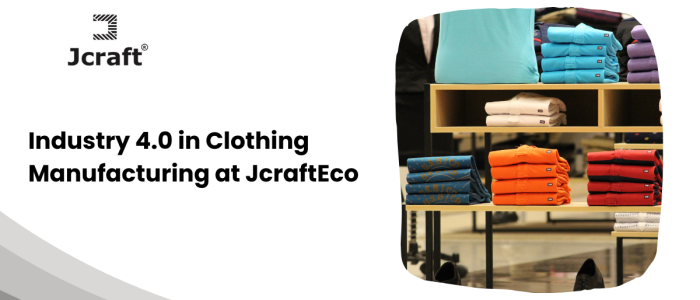Industry 4.0 in Clothing Manufacturing at JcraftEco

The garment industry is undergoing a dramatic transition towards Industry 4.0 in this age of rapid technological development. As an organic clothing manufacturers in India, JcraftEco is all about embracing digital transformation to make our manufacturing processes more efficient, sustainable, and top-notch.
How is Industry 4.0 changing the clothing manufacturing process?
In bygone eras, workers performed every task in the factory. Now, in the era of Industry 4.0:
- Robots do precise fabric spreading and cutting.
- Machines aid with stitching and can recall ways to better
- Robots expedite the packaging process.
- Enhanced quality due to fewer errors
How can Industry 4.0 benefit garment manufacturers?
1. Intelligent machinery for improved quality
Robots and smart machines learn fast and remember things, so if they make a mistake, they can be reprogrammed to not make the same one. In contrast to human workers, who sometimes make mistakes due to fatigue, illness, or lack of training, intelligent machines and robots consistently produce high-quality goods that are correctly built. Quality assurance and manufacturing procedures, such as cutting, benefit from image processing's increased accuracy.
2. Making decisions quickly using data in real-time
Data is the lifeblood of smart factories driven by Industry 4.0. In order to enable managers to make critical manufacturing choices on the fly, machine sensors gather data from the production line in real time. Manufacturers can simplify their entire production process by using collected data to analyze all aspects effecting production speed.
3. A higher number of orders results in larger profits.
With a more precise and efficient production line, managers will be able to take on more orders. Machines designed for heavy use are more capable of handling a greater volume of work than human laborers, especially in harsh industrial environments. Staff time is freed up by networked machines since they share data and allow closer monitoring of each stage of production. Manufacturers that were previously limited to the domestic market may now compete on a worldwide scale, boosting their production and profit, all because of interconnected smart machines.
Also read: How to Improve Lead Times in Apparel Manufacturing?
4. Clients are kept updated
Customers are typically left out of the production process when manufacturers take their orders, with the exception of occasional updates. By making consumers feel like they are an essential component of the process, smart devices improve communication. Thanks to online technologies, clients can easily track the progress of their orders and stay updated on any changes to production timelines. This improves their planning process and makes it more convenient for them. With the knowledge that the data supplied is trustworthy, machine-generated information, customers may keep in touch with manufacturers while also keeping tabs on real-time reports.
5. Automate to save money
Although it's a worthy investment, the start-up expenses of equipping a whole factory with new, interconnected machines are expensive. The likelihood of product recalls in the future is decreased by the use of automation, which decreases production errors. Because of this, factories can take on large orders without worrying about compromising quality.
In addition to a management team, smart machines take the place of industrial personnel, cutting down on labor expenses like salary, training, and sick days. To increase output, current employees can be moved to different divisions.
6. Augmented reality (AR) for improved training
Everything, from staff training to garment manufacturing, is being revolutionized by Industry 4.0. Staff members can learn how to sew using augmented reality, which combines smart machinery with a digital setting. As a result of this intelligent training, human error is drastically reduced, and productivity can be increased by as much as 50%.
7. Top-notch Checks
Manual inspections are more important than machines in the conventional method of quality control. Some flawed items manage to get past the net, leading to consumer discontent or even harm as a result of human error caused by exhaustion or neglect. Using state-of-the-art image processing and machine learning, Industry 4.0 makes quality control a computer-assisted process that meticulously scans products for flaws. This extremely precise procedure eliminates the possibility of human error by doing away with human intervention.
8. Repeat orders are a sign of a happy consumer.
With the use of big data and smart machines, we can store production data more comprehensively, which boosts machine accuracy and productivity. As smart robots standardize most aspects of production, less manual labor means a more precise production line. By scanning things with the use of smart machines and image processing, comprehensive quality control checks are also made possible. Less product failures and happy clients equal more repeat business and a great reputation for the factory.
Conclusion
Efficiency, sustainability, and innovation are the guiding principles of JcraftEco's future garment production as the company embraces Industry 4.0. Our story showcases how technology can revolutionize manufacturing by making it more responsible and responsive.
